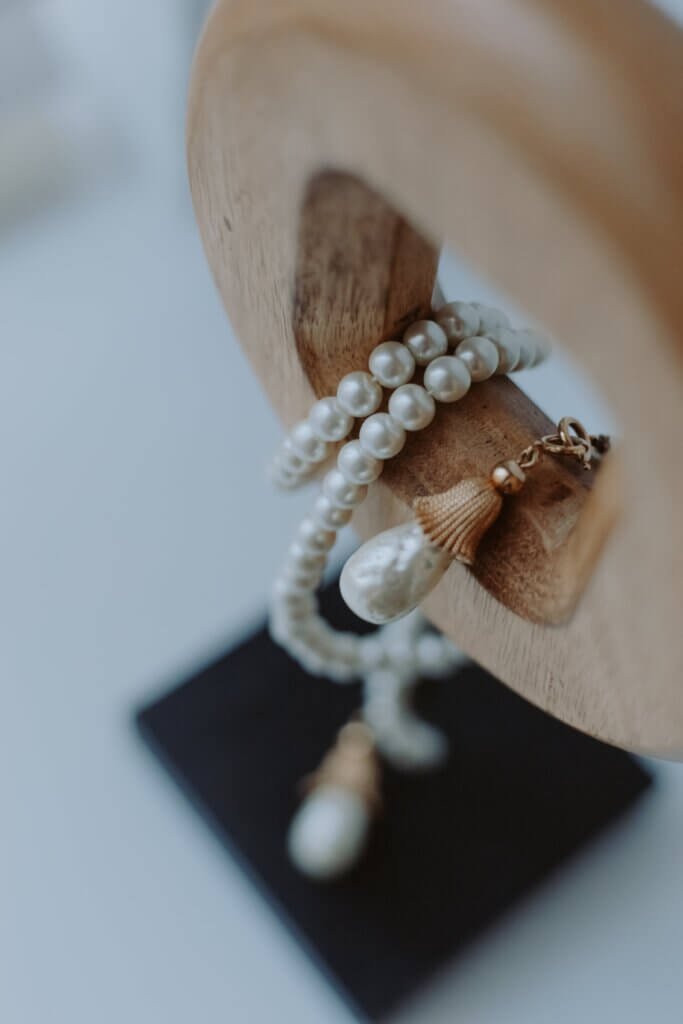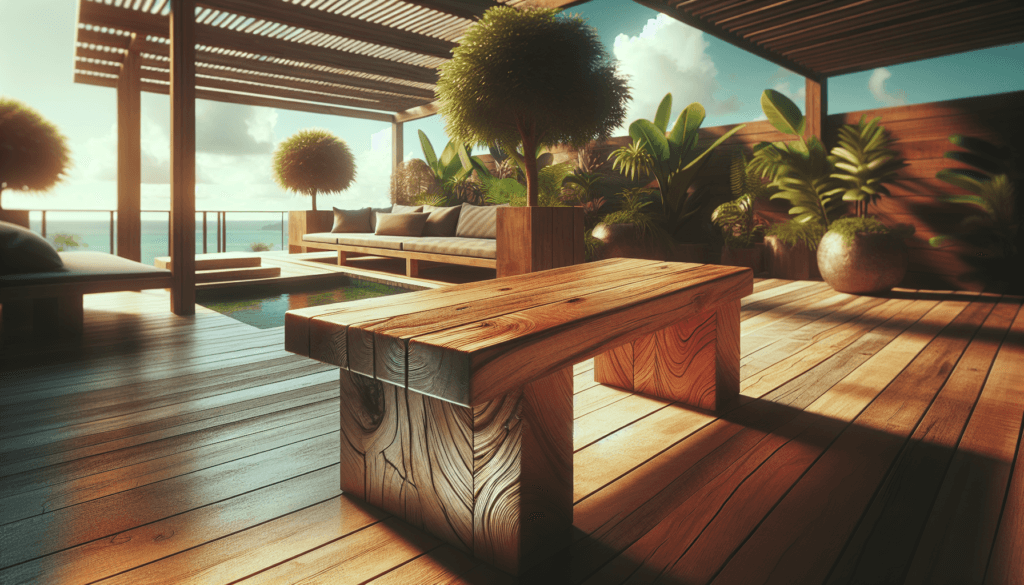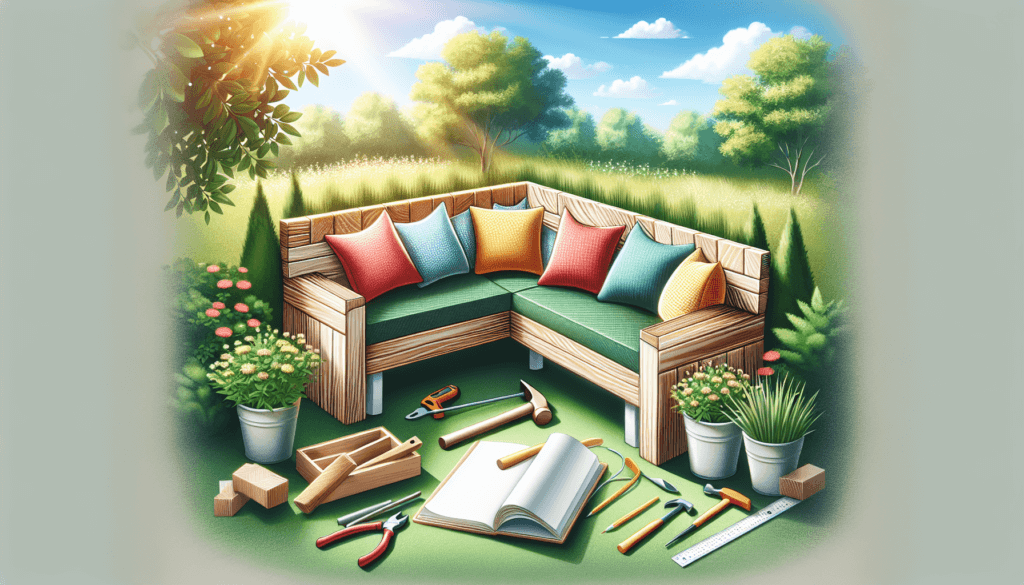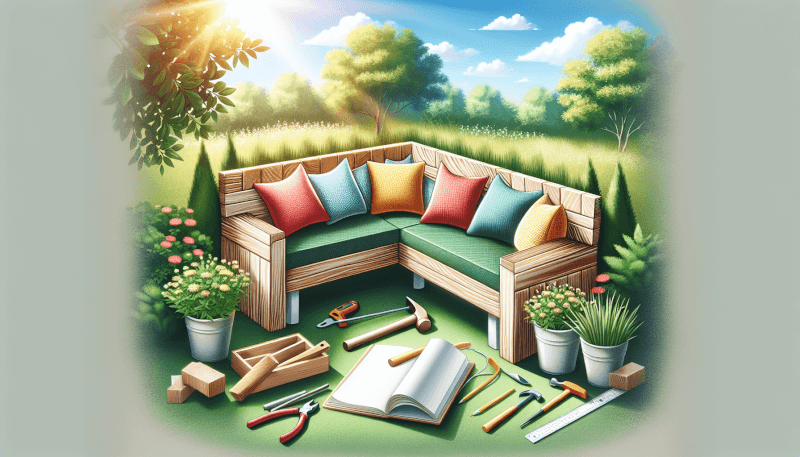Imagine enjoying the warm sunshine on a beautiful summer day, surrounded by the refreshing scent of nature, while lounging in your very own DIY outdoor seating area. In this article, we will guide you step by step on how to create the perfect outdoor oasis in your backyard. From choosing the right location to selecting the materials and assembling the seating area, we’ve got you covered. Get ready to unleash your creativity and transform your outdoor space into a cozy and inviting retreat!

Planning and Design
Assessing the available space
Before you begin constructing your outdoor seating area, it’s important to assess the available space in your backyard or patio. Consider how much room you have and the layout of your outdoor area. Look for an open, flat space that can accommodate the seating and allow for adequate movement and comfort.
Determining the seating capacity
Next, determine how many people you want your outdoor seating area to accommodate. This will help you decide on the size and number of benches or chairs you need to build. Consider the number of family members, friends, or guests you typically entertain in your outdoor space.
Choosing the seating style
Once you have determined the seating capacity, it’s time to choose the seating style that suits your preferences and the overall design of your outdoor area. You can opt for individual chairs, benches, or a combination of both. Consider the comfort, functionality, and aesthetic appeal of each option.
Sketching the layout
Sketching the layout of your outdoor seating area can help you visualize the final result and ensure that everything fits harmoniously in the space. Take measurements and create a scaled drawing, marking the location of benches, chairs, tables, and any other elements you plan to incorporate. This will serve as a guide during the construction process.
Considering climate and weather conditions
When planning your outdoor seating area, it’s essential to consider the climate and weather conditions in your area. Different materials and finishes may be more suitable for certain climates. For example, if you live in a humid or coastal region, you may want to choose weather-resistant materials or finishes to prevent damage from moisture and salt air.
Materials and Tools
Selecting the appropriate wood
When building your outdoor seating area, selecting the right type of wood is crucial for durability and longevity. Opt for weather-resistant options such as cedar, teak, or redwood, as they are naturally resistant to decay and insects. These woods also have an attractive appearance that will enhance the aesthetic appeal of your outdoor space.
Gathering necessary hardware
To ensure the sturdiness and stability of your seating area, it’s important to gather the necessary hardware. This may include screws, nails, bolts, and brackets. Choose hardware that is corrosion-resistant and specifically designed for outdoor use to prevent rusting or weakening over time.
Choosing comfortable cushions and pillows
To make your outdoor seating area cozy and inviting, choose comfortable cushions and pillows. Look for weather-resistant and easy-to-clean options, such as outdoor fabrics that are resistant to fading and mildew. Don’t forget to consider the colors and patterns that will complement your overall design scheme.
Considering weather-resistant finishes
Applying a weather-resistant finish to your outdoor seating area will help protect the wood from moisture, UV rays, and other outdoor elements. Consider using a sealant or exterior-grade paint that is specifically designed for outdoor use. This will not only enhance the durability of your seating area but also add a polished and finished look.
Collecting essential tools
Before you start building your outdoor seating area, make sure you have all the necessary tools on hand. These may include a saw, drill, hammer, tape measure, level, and various types of screwdrivers. Having the right tools readily available will make the construction process smoother and more efficient.

Preparation and Site Preparation
Measuring and marking the area
Before you start preparing the site for your outdoor seating area, measure and mark the designated area. This will ensure that the dimensions are accurate, and the seating area is properly aligned with the overall layout of your outdoor space. Use a tape measure and stakes to mark the corners and edges of the area.
Clearing vegetation and debris
To create a clean and level surface for your outdoor seating area, clear away any vegetation, plants, or debris. This may include grass, weeds, rocks, or fallen branches. Use a rake or shovel to remove the vegetation and ensure that the ground is clear and ready for the next step.
Leveling the ground
To ensure the stability and comfort of your seating area, it’s important to level the ground. Use a level and a straight board to check for any unevenness. If you notice any high or low spots, use a shovel or rake to even out the ground. A flat and level surface will prevent wobbling or rocking of your seating structure.
Applying weed barrier fabric
To prevent weeds from growing through your seating area, it’s recommended to apply a weed barrier fabric. This fabric will help suppress weed growth while still allowing water to drain freely. Cut the fabric to fit the dimensions of your seating area and secure it in place using landscape staples or heavy-duty adhesive.
Creating a base using gravel or sand
Creating a stable and well-drained base is important for the longevity of your outdoor seating area. One way to achieve this is by using gravel or sand. Spread a layer of gravel or sand evenly over the weed barrier fabric, ensuring that it is level and compacted. This base will provide a solid foundation for your seating platform.
Building the Seating Platform
Cutting and assembling the frame
Now it’s time to start building the seating platform. Begin by cutting the wood to the appropriate lengths and assembling the frame. Use a saw and appropriate-sized screws or nails to secure the pieces together. Double-check your measurements and squareness as you go to ensure a proper fit.
Attaching support beams
To provide additional support and stability, attach support beams across the frame of your seating platform. These beams will help distribute the weight evenly, preventing any sagging or potential structural issues over time. Use screws or nails to secure the support beams to the frame.
Securing the frame to the ground
Once your seating platform is assembled, it’s important to secure it to the ground to prevent any movement or instability. Use L-brackets or anchors to attach the frame to the ground. Make sure to fasten the pieces securely, ensuring that the seating platform is level and stable.
Installing a backrest or retaining wall
Depending on the design of your seating platform, you may want to install a backrest or a retaining wall at the back of the seating area. This will add comfort and support, as well as prevent cushions or pillows from falling off the back. Secure the backrest or retaining wall to the frame using appropriate hardware.
Adding braces for stability
To ensure the utmost stability of your seating platform, consider adding braces in strategic locations. Braces can be placed diagonally or horizontally between the frame and the ground, providing additional support against any potential wobbling or rocking. Use screws or bolts to secure the braces firmly in place.

Constructing Seating Elements
Building benches or chairs
Now that your seating platform is complete, it’s time to construct the benches or chairs that will provide the seating. Cut the wood to the appropriate lengths and build the seating elements according to your desired design. Ensure that the seats are comfortable and proportionate to the seating platform.
Creating storage compartments
If you’re looking for additional functionality, consider incorporating storage compartments into your seating area. These compartments can be built directly into the benches or chairs, providing a convenient space to store cushions, pillows, or other outdoor essentials. Use hinges and latches to create easy access to the storage compartments.
Incorporating built-in armrests or side tables
To enhance the comfort and usability of your outdoor seating area, incorporate built-in armrests or side tables. These can be attached to the benches or chairs to provide a place to rest drinks, books, or other items. Choose wood that complements the overall design and finish it to match the seating platform.
Designing custom features
Make your outdoor seating area unique by incorporating custom features that suit your preferences and needs. This could include built-in cup holders, magazine racks, or even USB charging ports. The possibilities are endless, so let your creativity and practicality guide you in designing custom features that will enhance your outdoor experience.
Using recycled or repurposed materials
If you’re looking to minimize waste and reduce the environmental impact of your outdoor seating area, consider using recycled or repurposed materials. Look for reclaimed wood, old doors, or pallets that can be transformed into seating elements. Not only will this give your seating area a unique and rustic charm, but it will also contribute to sustainable practices.
Adding Comfort and Style
Choosing suitable cushions and fabrics
To create a comfortable and inviting outdoor seating area, choose suitable cushions and fabrics. Opt for materials that are weather-resistant and easy to clean, such as outdoor-rated fabrics or synthetic fibers. Consider the colors, patterns, and textures that will complement your outdoor space and add a touch of style.
Opting for weather-resistant and easy-to-clean options
When selecting cushions and fabrics, prioritize weather resistance and ease of cleaning. Outdoor-rated fabrics are designed to withstand harsh outdoor conditions and resist fading, mildew, and stains. Look for cushions with removable covers that can be easily washed or wiped clean. This will ensure that your seating area remains comfortable and low-maintenance.
Considering decorative elements
Adding decorative elements to your outdoor seating area can enhance its visual appeal and create a cohesive design. Consider incorporating throw pillows, outdoor rugs, or decorative planters that coordinate with the color scheme and style of your outdoor space. These small touches can make a big difference in creating a welcoming and inviting atmosphere.
Adding lighting fixtures
To extend the usability of your outdoor seating area into the evening, consider adding lighting fixtures. This could include overhead string lights, lanterns, or even built-in LED lights. Illuminate the space strategically to create a warm and cozy ambiance, while also providing functional lighting for nighttime activities.
Including planters or greenery
Integrating planters or greenery into your outdoor seating area can bring life and freshness to the space. Consider adding potted plants or hanging baskets, which can provide a pop of color and a natural element to your seating area. Choose plants that thrive in the outdoor conditions of your region and require minimal maintenance.

Finishing Touches
Sanding and smoothing the surfaces
Before applying any finish or paint, make sure to sand and smooth the surfaces of your seating area. Sanding will remove any rough edges or splinters and create a smooth and comfortable seating surface. Start with coarse-grit sandpaper and gradually move to finer grits for a polished and refined finish.
Applying a protective finish
To protect the wood from moisture, UV rays, and other outdoor elements, apply a protective finish. This could be a clear sealant, an exterior-grade stain, or paint specifically designed for outdoor use. Follow the manufacturer’s instructions for proper application and allow sufficient drying time before using the seating area.
Painting or staining the seating
If you prefer to add color or a specific aesthetic to your outdoor seating area, consider painting or staining the wood. Choose paint or stain that is specifically formulated for exterior use and follow the instructions carefully. Apply multiple coats for a solid and long-lasting finish, and allow each coat to dry completely before applying the next.
Installing optional features (e.g., umbrella holders)
As a final touch, consider installing optional features that will enhance the functionality of your outdoor seating area. This could include umbrella holders to provide shade on hot days or hooks to hang towels, hats, or other items. These small additions can make your outdoor space more convenient and enjoyable.
Double-checking stability and safety
Once you have completed the construction and added all the finishing touches, double-check the stability and safety of your outdoor seating area. Sit on the benches or chairs, apply pressure, and ensure that everything is secure and stable. Make any necessary adjustments or reinforcements to ensure the utmost safety and comfort for you and your guests.
Maintenance and Care
Cleaning the seating area regularly
Regular cleaning is essential to maintain the beauty and cleanliness of your outdoor seating area. Remove any debris, dirt, or leaves from the seating surface and any crevices. Use a mild soap or a specialized outdoor furniture cleaner and a soft brush to scrub away any stains or grime. Rinse thoroughly with a hose and allow the seating area to dry completely before use.
Covering or storing cushions during extreme weather
To prolong the lifespan of your cushions, it’s recommended to cover or store them during extreme weather conditions. Use weatherproof covers or bring the cushions indoors during heavy rain, snow, or strong sunlight. This will prevent fading, moisture damage, or mold growth, ensuring that your cushions remain in good condition for years to come.
Repairing or replacing damaged components
Over time, components of your outdoor seating area may become damaged or worn out. It’s important to regularly inspect and repair any issues to maintain the functionality and safety of the seating area. Replace any broken or weakened boards, tighten loose screws, and address any structural concerns promptly.
Reapplying protective finishes
To keep your outdoor seating area looking fresh and protected, periodically reapply the protective finishes. Over time, finishes may wear off due to weather exposure. Follow the recommended maintenance schedule provided by the manufacturer or apply a fresh coat of sealant, stain, or paint as needed.
Seasonal maintenance checklist
Having a seasonal maintenance checklist can help you stay organized and ensure that your outdoor seating area remains in top shape throughout the year. This checklist may include tasks such as cleaning, inspecting for damage, applying protective finishes, and storing cushions or other removable elements. Regular maintenance will extend the lifespan and enjoyment of your seating area.

Safety Considerations
Ensuring proper weight capacity
When designing and constructing your outdoor seating area, it’s important to ensure that it can safely support the intended weight capacity. Consider the materials used, the design of the seating platform, and the structural integrity of the benches or chairs. Follow weight capacity guidelines provided by the manufacturer or consult a professional if necessary.
Using sturdy and durable materials
To ensure the safety and longevity of your outdoor seating area, use sturdy and durable materials. Opt for high-quality wood, hardware, and finishes that can withstand outdoor conditions and regular use. Avoid using flimsy or untested materials that may compromise the structural integrity of the seating area.
Securing the seating against tipping
To prevent accidents or injuries, it’s important to secure your outdoor seating area against tipping. If your seating platform is elevated, make sure it is securely fastened to the ground or a sturdy base. Consider adding additional supports or braces to prevent any wobbling or instability.
Creating a non-slip surface
Safety is paramount in an outdoor seating area, particularly when it comes to preventing slips and falls. Choose materials, finishes, and cushions that provide a non-slip surface, even when wet. Consider adding non-slip pads or mats to the bottom of benches or chairs to prevent movement on smooth surfaces.
Avoiding sharp edges or protrusions
When building your outdoor seating area, be mindful of any sharp edges or protrusions that may pose a safety risk. Sand down any rough edges or use a router to round them off. Ensure that all hardware, such as screws or nails, is properly countersunk to avoid snagging clothing or causing injuries.
Alternative Options and Ideas
Using pallets or crates for a budget-friendly approach
If you’re looking for a budget-friendly approach to building your outdoor seating area, consider using pallets or crates. These can be repurposed into benches, chairs, or even tables with some modifications. Sand and finish the pallets or crates to ensure a smooth and comfortable seating surface.
Building a pergola or gazebo with integrated seating
If you’re aiming for a more elaborate outdoor seating area, consider building a pergola or gazebo with integrated seating. This will create a shaded and cozy space to relax and entertain. Combine benches, chairs, or even swings within the structure to enhance the comfort and style of your outdoor space.
Incorporating a fire pit or outdoor fireplace
For cooler evenings or a cozy ambiance, consider incorporating a fire pit or outdoor fireplace into your seating area. This will provide warmth and create a focal point for gathering and conversation. Ensure that the seating is placed at a safe distance from the fire feature and follow all local fire regulations.
Creating a modular seating system
If you love flexibility and versatility, consider creating a modular seating system for your outdoor area. This allows you to rearrange the seating elements to suit different occasions or preferences. Use individual chairs or benches that can be easily moved around and combined to create various seating configurations.
Choosing different seating styles (e.g., hammocks, swings)
If you’re seeking a unique and laid-back seating experience, consider incorporating hammocks or swings into your outdoor area. These seating styles provide a fun and relaxing atmosphere. Ensure that the structure supporting the hammocks or swings is sturdy and secure, and follow all safety recommendations provided by the manufacturer.
Building your own DIY outdoor seating area can be a rewarding and enjoyable project. By following the planning and design steps, gathering the necessary materials and tools, and carefully constructing the seating platform and seating elements, you can create a comfortable and stylish space to relax and entertain. Maintain your seating area with regular cleaning and maintenance, follow safety considerations, and consider alternative options and ideas to customize your outdoor space to your liking. Enjoy the process and the endless possibilities of building your own outdoor seating area!


